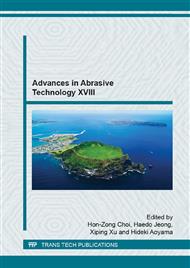p.497
p.503
p.509
p.515
p.520
p.526
p.531
p.537
p.543
High-Speed Capturing of Stress Distribution of Workpiece under Ultrasonically Assisted Cutting Condition
Abstract:
This paper reports the stress distribution inside the workpiece under ultrasonic vibration cutting (UVC) condition. Many researchers have reported the improvements of tool wear, burr generation and surface integrity by reduction of time-averaged cutting force under UVC condition. However general dynamometers have an insufficient frequency band to observe the ultrasonically varying processing phenomena induced by UVC. In this paper, stress distribution inside the workpiece was observed by combining the pulse laser as light source synchronized with ultrasonically vibrating cutting tool and the photoelastic method. The one shot of pulse laser with pulse width of 15nsec visualizes an instantaneous stress distribution. Sweeping the phase of emission against to ultrasonic oscillation, 360 frames for 35.7μs, one period of ultrasonic oscillation, are captured. Because UVC induced an intermittent cutting condition, the stress distribution changed periodically and disappeared when the tool leaved from the workpiece. The ideal chip-generating period is calculated by relative motion between tool and work. We found that the actual chip-generating period was extremely longer than ideal period.
Info:
Periodical:
Pages:
520-525
Citation:
Online since:
January 2016
Authors:
Price:
Сopyright:
© 2016 Trans Tech Publications Ltd. All Rights Reserved
Share:
Citation:


